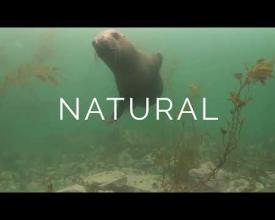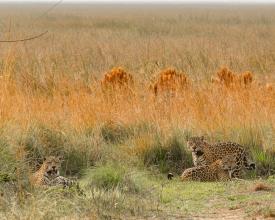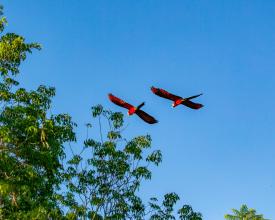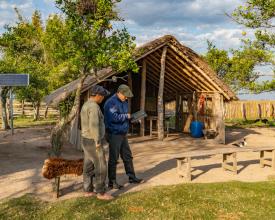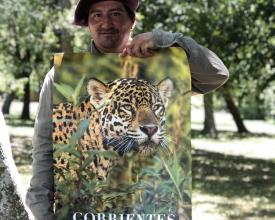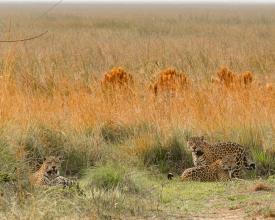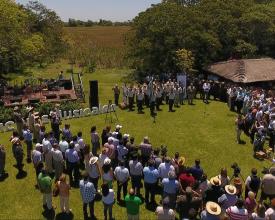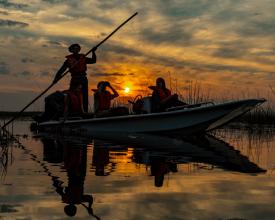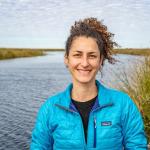
Multispecies reintroduction project in the Iberá Park, Corrientes, Argentina
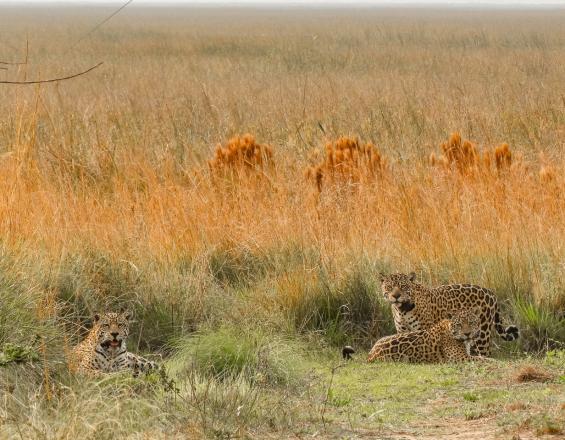
We apply the model of Full Nature, a virtuous cycle where protected areas with complete ecosystems become the basis for a restorative economy based in ecotourism, benefiting local communities, who will act as the main stewards of the parks.
The Great Iberá Park is a 700,000-ha with 550,000 composed by the Iberá Provincial Park, and 150,000 acquired, recovered and donated by our foundation to the Argentine state to create the Iberá National Park.
Through rewilding, locally extinct species with critical ecological roles including predators and herbivores are being reintroduced and consolidating numerically functional populations. This multispecies approach aims to reverse the crisis of biodiversity loss and climate change, by helping increasing carbon sequestration in these ecosystems.
By promoting “Iberá” as an ecotourism destination, it becomes an economic engine for local development. Thus, locals receive a tangible benefit from conservation, and become proud and protective of the protected area and its natural resources.
Context
Challenges addressed
General challenges
- Soursing initial population nuclei with captive bred animals imply a challenge for them to adapt to life in freedom.
Social challenges
- Initially, the project which involved purchasing former cattle ranches to transform them in to protected areas generated a skeptical reaction in general public, and even translated into a national law that forbid strangers to purchase lands in Argentina. The later donation of these lands to the national government to create a National Park which currently generates local benefits, helped dispelling the initial opposition.
- The transition from a traditional passive conservation, to an active ecosystem management caused negative reactions in stakeholders, such as wildlife authorities, academia, NGOs, etc. Reintroductions were not common in Argentina, and carrying out several species reintroductions generated a disapproval supported by common arguments.
Location
Process
Summary of the process
Through the creation of protected areas wich can be either created by or donated to federal and provincial governments we guarantee the protection of land portions of lands. In these lands, ecosystems restoration takes place, mainly by reintroducing species that were locally extinct, if that is the case, or working in increasing populations of species that are low in numbers due tu previous human causes, as well as controlling exotic species and reducing other threats. Most often, we work with species deemed to have large impacts at the ecosystem level, such as large predators and herbivores. Along with ecosystem restoration, the development of public use infrastructure, capacity building and publicity to create an economy based on ecotourism in needed for creating an economic incentive to conserve native wildlife and habitats. Once local recognize the bennefits of having a protected area nearby, they will be the ones defending it and being proud of their natural and cultural heritage.
Building Blocks
Rewilding for restoring key species and their ecological roles in a degraded ecosystem
We developed the Iberá Rewilding Program, aimed at
re-establishing sustainable populations of all locally extirpated
fauna. These reintroductions are mainly aimed to advance ecological restoration instead of individual species endangered recovery. Also, focusing in the restoration of key species which effect in the ecosystem is stronger, we guarantee the restoration of their role and the recovery of a healthy and balanced ecosystem
Enabling factors
- Planning, feasibility assessments and permits
-Source of animals
- Quarantine phase and hand-rearing
-Pre-release phase
-Release of individuals
- Individuals monitoring
- Reintroduced population monitoring and demographic evaluation
- Demographic assessment
- Communication and program evaluation
Lesson learned
We recognize two main organizational strengths that have
helped us to achieve our rewilding results in Iberá: the availability of large areas of high-quality and well-protected habitat for
released animals (some of which were owned and managed by us),
and the existence of long-term funding that allowed us to work
for more than 10 years. These advantages are not always available
to reintroduction projects, which usually face difficulties in habitat
and funding availability.
Large Parks creation
The national and provincial parks are public spaces that have the most effective legal protection for the conservation of biodiversity. It is for this reason that our organization strives to acquire and donate land to the nation and to the provinces to create parks. Ours is an unprecedented process whereby large private areas of land, that were degraded and closed to the public, are restored and passed into the hands of the State, and are open to all to be visited and enjoyed.
These spaces invite us to connect with nature through wildlife watching and other outdoor experiences.
Enabling factors
- Large portions of preserved natural ecosystems, either already public or private that could be acquired.
-Public authorities understanding the need to create protected areas, both by the beneffits to nature and to people through a healthy ecosystem and economical beneffits from ecotourism development
-Public access to guarantee the visitation of these areas
Lesson learned
Additionally, we found that relating the creation of parks to local development is a useful way to gain support from politicians, top-level decision-makers and neighbors. We discovered that, in order to make the public feel as part of the project and protected areas, we needed to acknowledge their role and impact on the program’s results. In this way, people felt like active participants in teh creation of protected areas, species recovery, adopting and supporting the project’s goals.
Community prosperity through developing nature-based tourism
The well-being of the communities close to the parks is essential for the success of our strategy. Complete, functioning and healthy ecosystems will not only assure important environmental services like clean water, clean air and the mitigation of floods, but they also offer new opportunities to develop sustainable economies.
These areas usually have great potential, but they also face important threats. The ecosystems are usually degraded and are not considered locally as a source of opportunity or income. Also, these places on the edges of protected areas usually have populations with high level of poverty and high rates of out-migration to big cities.
We work along with these communities to create a path to a new sustainable economy, directly linked to opportunities that come from the creation of new protected areas and to the return of wildlife. We act to empower community leaders and women, strengthen the connection of the youth to their homeland and their environment, train people in new trades and build relationships based on trust and respect.
Enabling factors
Work together with local communities and local, provincial and national governments in the development of tourism “circuits” that offer spectacular landscape as well as wildlife-viewing experiences, at gateways, or entrances, to the protected areas or parks.
Empower and build the capacity of local entrepreneurs with trainings and workshops, so that they can be the first to benefit from these new activities based on wildlife and nature. Finally, promote these destinations and experiences to a broad public to attract tourists.
Lesson learned
Nature-based tourism has been growing globally at rates of more than 4% per year, particularly in low- and middle-income countries. Charismatic fauna, including large predators, are becoming increasingly important. In the Brazilian Pantanal, the world’s largest wetland, wildlife viewing — mostly of jaguars — generated an annual revenue millions of dollars per year; many times the revenue obtained from traditional cattle ranching in that region.
Impacts
- 158,000 hectares (390,000 acres or 616 square miles) of lands and infrastructure for public use donated to the nation to create the Iberá National Park.
- nine species ongoing reintroductions, among them, collared peccaries (Pecari tajacu), giant anteaters (Myrmecophaga tridactyla), Pampas deer (Ozotoceros bezoarticus), red-and-green macaws (Ara chloropterus), bare-faced curassows (Crax fasciolata), jaguars (Panthera onca), giant otters (Pteronura brasiliensis), ocelots (Leopardus pardalis) and red- legged seriemas (Seriema crestata) are already or in process to be reintroduced in Iberá.
- Iberá scenic route with 10 access gateways to the Iberá Park
- + 40,000 tourists visiting the Iberá Park in 2021in search of wildlife, making ecotourism the fastest growing economic activity in the region, and the main source of job opportunities in at least one of the neighboring communities.
- 264 million metric tonnes of sequestered carbon
Beneficiaries
- Local communities benefit from Iberá's restoration, by provinding them a sustainable economic source through ecotourism, bringing also opportunities to women and youngs
- People also benefits from healthy ecosystems, which help reducing climate change effects
Sustainable Development Goals
Story
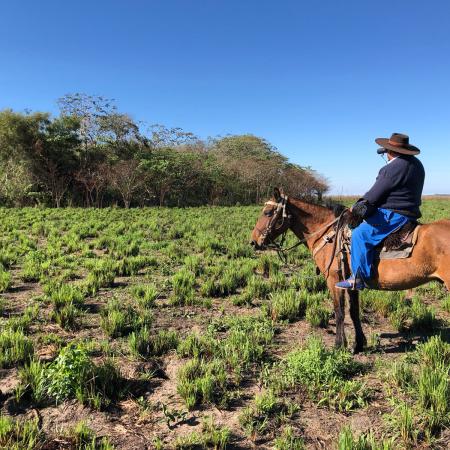
Omar Rojas is a local villager who worked all his life with cattle. For more than 30 years, he lived in the San Alonso island, in the core of the Iberá wetland as foreman of a cattle ranch with hundreds of cows. After the island was purchased by Fundación Rewilding Argentina in 1997, Omar stayed a little bit longer and then decided to move to his own land to keep on working with his cattle. Progressively, cattle was removed from San Alonso where reintroduction projects started to be carried out, including the return of the giant anteater, the Pampas deer, the collared peccary, the giant otter and the jaguar. At the same time, Iberá started to become an ecotourism attraction, and more and more people started visiting the area in search of wildlife and traditional culture. Thus, with his expereicne, Omar started offering tourists horseriding excursions which even included swimming with horses, as he used to do years before to move cattle from the island to the mainland. These excursions became more and more popular, and Omar is currently living almost from ecotourism. This year, Omar and his wife Antonia, visited San Alonso, where they could see the first jaguars roaming free in Iberá, after more than half a century. After the encounter with the jaguar, he expressed he couldn not ask for anything else in his life.

